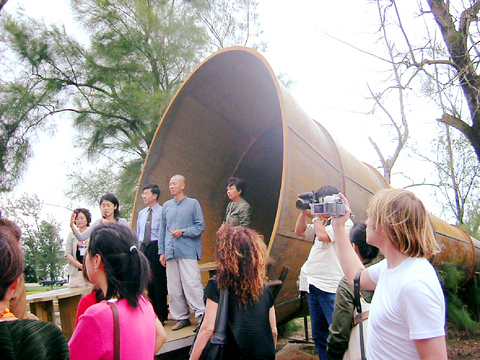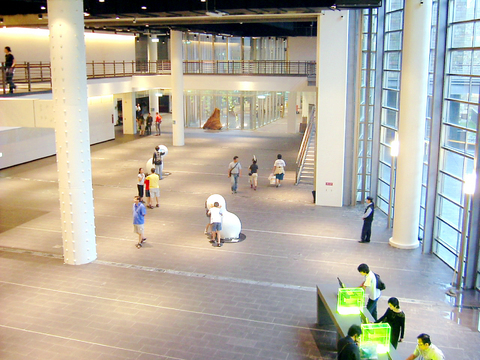It's that time of the year: the end of the year when many publications take a fond look and assess the year's achievements and failures. And so, with no further ado, the Taipei Times takes a look at some of the highs and lows in Taiwan's contemporary art for the year 2004.
Glorious epiphanies

PHOTO: SUSAN KENDZULAK
1. Who needs curators anyway? Some of the best exhibitions in Taiwan were organized by local artists, which only helped to prove the point that decisions about art should mainly be left up to artists. Yao Jui-chung (

PHOTO: SUSAN KENDZULAK
2. The Bunker Museum of Contemporary Art in Kinmen (formerly known as Quemoy) was also organized by an artist. Cai Guo-Qiang (
3. Treasure Hill is one of the great jewels of Taipei City. Near National Taiwan University, this cluster of unassuming ramshackle homes that overlooks the Hsindian River was also home to a very inspiring art residency program.
4. Art can be fun. Artist Huang Shih-chieh's (
5. The debut of artist Peng Hung-Chih's (
6. Artist residencies, both here and abroad were such a boon to the artists who participated in them. At the beginning of the year, there was a British-Taiwan exchange. Programs like these act as a kind of cultural diplomacy.
7. Ava Hsueh's (
San Francisco's Asian Art Museum hosted Spaces Within featuring Wu Mali's (
8. The openings/renovations of some new art spaces such as Taipei MOMA and Taichung's National Taiwan Museum of Fine Arts provided fresh perspectives and viewing areas.
9. And let's give a "yo" out to the alternative weekly paper POTs which became more bilingual this year and focuses on local cultural events quite well.
The biggest bombs
1. Do we really need another coffee shop? How do we keep up with the chaotic changes at government-funded cultural venues such as the Taipei Artist Village and Huashan?
2. The Auckland Triennial and Shanghai Biennial included some Taiwanese artists; however, these major exhibitions were rather lackluster, so who cares.
3. Again another digital show, the "Digital Sublime: New Masters of the Universe" at MOCA was heavy on the technology and light on the substance.
4. Nankang Software Park's public art. With a budget of NT$72 million, you'd think the organizers could pay for larger sculptures instead of ending up with something that looks straight out of the Stonehenge scene from This is Spinal Tap.
5. Fiction, Love-Ultra New Vision in Contemporary Art was a well-attended show due to its overwhelming inclusion of cutesy kitsch. However, many works did not fit into the premise of comics and animation.
6. Let's award a couple of bian dang to the catfighting curators of this year's Taipei Biennial. Perhaps to some people, international negative attention is better than no attention at all.
7. The UNESCO group AICA's world congress recently held in Taipei and Kaohsiung showed that western arrogance is still alive and well in the post-modern art world.
8. With the exception of Yuan Goang-ming's (
9. The ping-ponging fate of the proposed Guggenheim. It would be great to have a Pritzker-prized architect-designed building in Taiwan.
10. Poor scheduling of international events. With several biennials and international conferences in Asia, coordination would allow foreign visitors to attend more than just one event.

June 9 to June 15 A photo of two men riding trendy high-wheel Penny-Farthing bicycles past a Qing Dynasty gate aptly captures the essence of Taipei in 1897 — a newly colonized city on the cusp of great change. The Japanese began making significant modifications to the cityscape in 1899, tearing down Qing-era structures, widening boulevards and installing Western-style infrastructure and buildings. The photographer, Minosuke Imamura, only spent a year in Taiwan as a cartographer for the governor-general’s office, but he left behind a treasure trove of 130 images showing life at the onset of Japanese rule, spanning July 1897 to

In an interview posted online by United Daily News (UDN) on May 26, current Chinese Nationalist Party (KMT) Chairman Eric Chu (朱立倫) was asked about Taichung Mayor Lu Shiow-yen (盧秀燕) replacing him as party chair. Though not yet officially running, by the customs of Taiwan politics, Lu has been signalling she is both running for party chair and to be the party’s 2028 presidential candidate. She told an international media outlet that she was considering a run. She also gave a speech in Keelung on national priorities and foreign affairs. For details, see the May 23 edition of this column,

At Computex 2025, Nvidia CEO Jensen Huang (黃仁勳) urged the government to subsidize AI. “All schools in Taiwan must integrate AI into their curricula,” he declared. A few months earlier, he said, “If I were a student today, I’d immediately start using tools like ChatGPT, Gemini Pro and Grok to learn, write and accelerate my thinking.” Huang sees the AI-bullet train leaving the station. And as one of its drivers, he’s worried about youth not getting on board — bad for their careers, and bad for his workforce. As a semiconductor supply-chain powerhouse and AI hub wannabe, Taiwan is seeing

Jade Mountain (玉山) — Taiwan’s highest peak — is the ultimate goal for those attempting a through-hike of the Mountains to Sea National Greenway (山海圳國家綠道), and that’s precisely where we’re headed in this final installment of a quartet of articles covering the Greenway. Picking up the trail at the Tsou tribal villages of Dabang and Tefuye, it’s worth stocking up on provisions before setting off, since — aside from the scant offerings available on the mountain’s Dongpu Lodge (東埔山莊) and Paiyun Lodge’s (排雲山莊) meal service — there’s nowhere to get food from here on out. TEFUYE HISTORIC TRAIL The journey recommences with